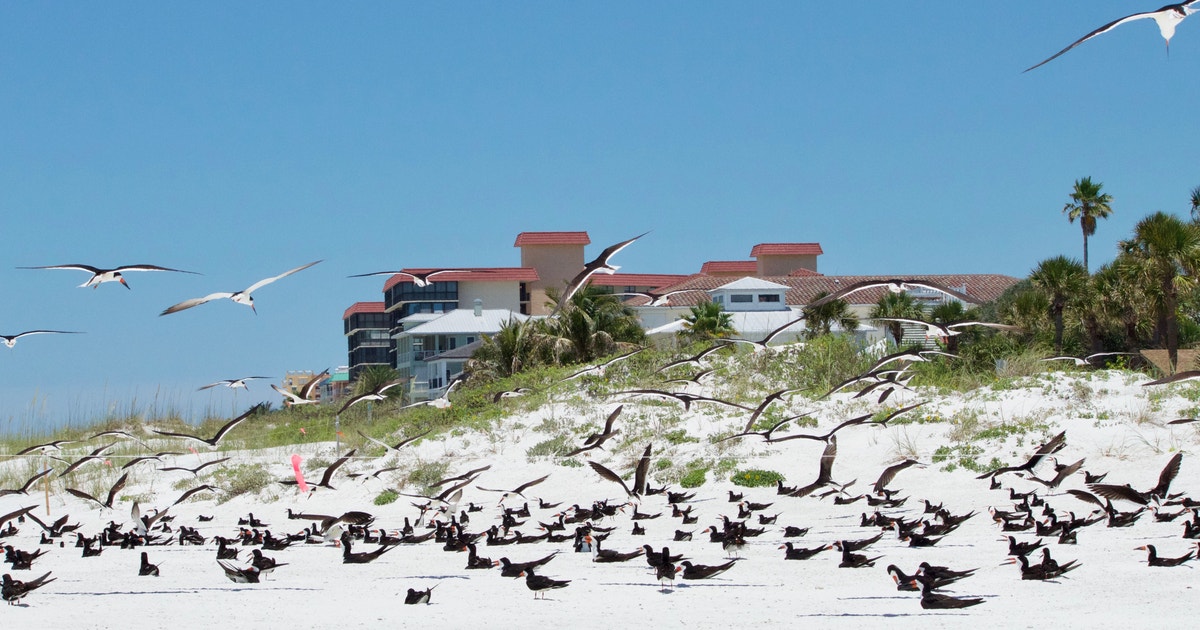Article by Santo Fiumano, Fort Myers (Lee County) Anchor Steward
You’re enjoying some peace when you suddenly hear a loud buzzing and look up. What is that? Many people have had this moment, surprised to see what looks like a hang glider or parachute with a person riding below, propelled by a motorized fan.
Taking Off in Popularity
Popping up in the 1980s, paramotors have seen a new wave of visibility and interest due to popular paramotor pilots posting videos of their flights to large online audiences.
It’s easy to see why people are enamored. Despite the known dangers associated with operating this type of device, hobbyists are attracted by the idea of flying freely in their own aircraft. Feeling the breeze on their face, the excitement of being suspended in the air, and on the cheaper end of things for a flying vehicle. But for our bird populations, this new means of catching some air has sometimes proven problematic.
Paramotor Parameters
Before a paramotorist can even get off the ground, they need to identify a good spot from which to launch. Open land is preferred, including environments like coastal dunes, large parks, and wetlands. This overlap of ideal paramotor launch and operation grounds and vital bird habitat sets the stage for difficulties caused by their co-occurrence.
Just how much does this cause issues for our birds? There have only been a few studies to date on paramotor influence on wild bird populations. Studies on disturbances caused by other light aerial devices, such as drones, have identified a variety of negative consequences. Namely, they can cause birds to flush: an involuntary movement away from a perceived threat, often resulting in birds leaving their feeding grounds or nesting areas.
This situation can be detrimental, causing feeding birds to expend their limited energy and reducing the time available to feed and regain it. In the case of nesting birds, flushing can result in eggs and chicks being exposed for extended periods of time, leading to them falling victim to weather, extreme temperatures, or predators. Repeated disturbance in this way may even cause nest abandonment or abandonment of the broader nesting area.
Studies specifically done on paramotor-created disturbance have unanimously echoed these points. When paramotors fly too close, birds flush more frequently, lose valuable feeding time, require increased energy to flee, and potentially abandon critical sites. These effects can ripple into worsening population decline.
Advice for Paramotorists
What can be done to avoid or reduce these harmful effects? According to staff with the Florida Fish & Wildlife Conservation Commission (FWC), it’s recommended that “personal aircrafts remain at least 300 feet from active shorebird, seabird, and wading bird nesting sites to reduce the likelihood of take (68A-27.003 F.A.C.). If nesting or roosting birds are responding to the presence of the aircraft, the distance should immediately be increased to help avoid further disturbance and potential take.”
“Take” includes actions that disturb, harass, harm, or kill wildlife. In my personal experience, I’ve seen disturbances to nesting birds by paramotor presence from up to a quarter mile away (1,320 ft). This is why the second part of this advice is so important. It’s always safest to keep more than the minimum distance, and to increase your distance (both from the birds and your altitude) if you notice the birds changing their behavior at all.
Another way to avoid causing disruptions to birds as you fly is to plan your route and check it for sensitive nesting, roosting, or brood-rearing sites by using the ShoreMapper app from FWC.
Our wild birds face many threats in the dynamic and changing modern world. Just a few of the most dire issues are pollution, habitat loss, and climate pressures. Paramotor and ultralight vehicle disturbances are, in comparison, easy to control. Always be perceptive of your environment, and before you fly, give some forethought to your route. A little planning will go a long way towards protecting Florida’s most vulnerable bird species.
Related resources:

